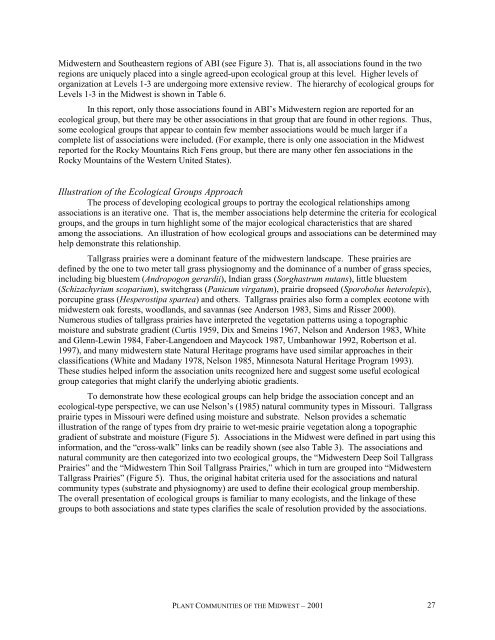Plant Communities of the Midwest - NatureServe
Plant Communities of the Midwest - NatureServe
Plant Communities of the Midwest - NatureServe
You also want an ePaper? Increase the reach of your titles
YUMPU automatically turns print PDFs into web optimized ePapers that Google loves.
<strong>Midwest</strong>ern and Sou<strong>the</strong>astern regions <strong>of</strong> ABI (see Figure 3). That is, all associations found in <strong>the</strong> two<br />
regions are uniquely placed into a single agreed-upon ecological group at this level. Higher levels <strong>of</strong><br />
organization at Levels 1-3 are undergoing more extensive review. The hierarchy <strong>of</strong> ecological groups for<br />
Levels 1-3 in <strong>the</strong> <strong>Midwest</strong> is shown in Table 6.<br />
In this report, only those associations found in ABI’s <strong>Midwest</strong>ern region are reported for an<br />
ecological group, but <strong>the</strong>re may be o<strong>the</strong>r associations in that group that are found in o<strong>the</strong>r regions. Thus,<br />
some ecological groups that appear to contain few member associations would be much larger if a<br />
complete list <strong>of</strong> associations were included. (For example, <strong>the</strong>re is only one association in <strong>the</strong> <strong>Midwest</strong><br />
reported for <strong>the</strong> Rocky Mountains Rich Fens group, but <strong>the</strong>re are many o<strong>the</strong>r fen associations in <strong>the</strong><br />
Rocky Mountains <strong>of</strong> <strong>the</strong> Western United States).<br />
Illustration <strong>of</strong> <strong>the</strong> Ecological Groups Approach<br />
The process <strong>of</strong> developing ecological groups to portray <strong>the</strong> ecological relationships among<br />
associations is an iterative one. That is, <strong>the</strong> member associations help determine <strong>the</strong> criteria for ecological<br />
groups, and <strong>the</strong> groups in turn highlight some <strong>of</strong> <strong>the</strong> major ecological characteristics that are shared<br />
among <strong>the</strong> associations. An illustration <strong>of</strong> how ecological groups and associations can be determined may<br />
help demonstrate this relationship.<br />
Tallgrass prairies were a dominant feature <strong>of</strong> <strong>the</strong> midwestern landscape. These prairies are<br />
defined by <strong>the</strong> one to two meter tall grass physiognomy and <strong>the</strong> dominance <strong>of</strong> a number <strong>of</strong> grass species,<br />
including big bluestem (Andropogon gerardii), Indian grass (Sorghastrum nutans), little bluestem<br />
(Schizachyrium scoparium), switchgrass (Panicum virgatum), prairie dropseed (Sporobolus heterolepis),<br />
porcupine grass (Hesperostipa spartea) and o<strong>the</strong>rs. Tallgrass prairies also form a complex ecotone with<br />
midwestern oak forests, woodlands, and savannas (see Anderson 1983, Sims and Risser 2000).<br />
Numerous studies <strong>of</strong> tallgrass prairies have interpreted <strong>the</strong> vegetation patterns using a topographic<br />
moisture and substrate gradient (Curtis 1959, Dix and Smeins 1967, Nelson and Anderson 1983, White<br />
and Glenn-Lewin 1984, Faber-Langendoen and Maycock 1987, Umbanhowar 1992, Robertson et al.<br />
1997), and many midwestern state Natural Heritage programs have used similar approaches in <strong>the</strong>ir<br />
classifications (White and Madany 1978, Nelson 1985, Minnesota Natural Heritage Program 1993).<br />
These studies helped inform <strong>the</strong> association units recognized here and suggest some useful ecological<br />
group categories that might clarify <strong>the</strong> underlying abiotic gradients.<br />
To demonstrate how <strong>the</strong>se ecological groups can help bridge <strong>the</strong> association concept and an<br />
ecological-type perspective, we can use Nelson’s (1985) natural community types in Missouri. Tallgrass<br />
prairie types in Missouri were defined using moisture and substrate. Nelson provides a schematic<br />
illustration <strong>of</strong> <strong>the</strong> range <strong>of</strong> types from dry prairie to wet-mesic prairie vegetation along a topographic<br />
gradient <strong>of</strong> substrate and moisture (Figure 5). Associations in <strong>the</strong> <strong>Midwest</strong> were defined in part using this<br />
information, and <strong>the</strong> “cross-walk” links can be readily shown (see also Table 3). The associations and<br />
natural community are <strong>the</strong>n categorized into two ecological groups, <strong>the</strong> “<strong>Midwest</strong>ern Deep Soil Tallgrass<br />
Prairies” and <strong>the</strong> “<strong>Midwest</strong>ern Thin Soil Tallgrass Prairies,” which in turn are grouped into “<strong>Midwest</strong>ern<br />
Tallgrass Prairies” (Figure 5). Thus, <strong>the</strong> original habitat criteria used for <strong>the</strong> associations and natural<br />
community types (substrate and physiognomy) are used to define <strong>the</strong>ir ecological group membership.<br />
The overall presentation <strong>of</strong> ecological groups is familiar to many ecologists, and <strong>the</strong> linkage <strong>of</strong> <strong>the</strong>se<br />
groups to both associations and state types clarifies <strong>the</strong> scale <strong>of</strong> resolution provided by <strong>the</strong> associations.<br />
PLANT COMMUNITIES OF THE MIDWEST – 2001<br />
27
















